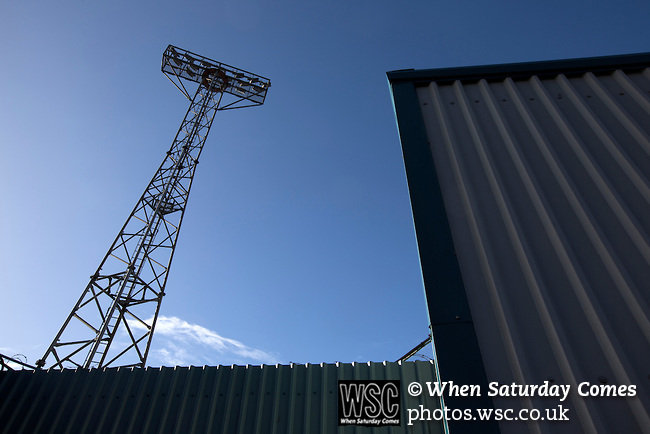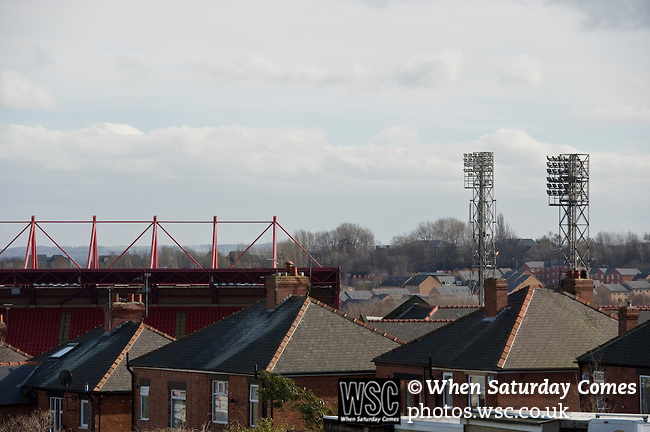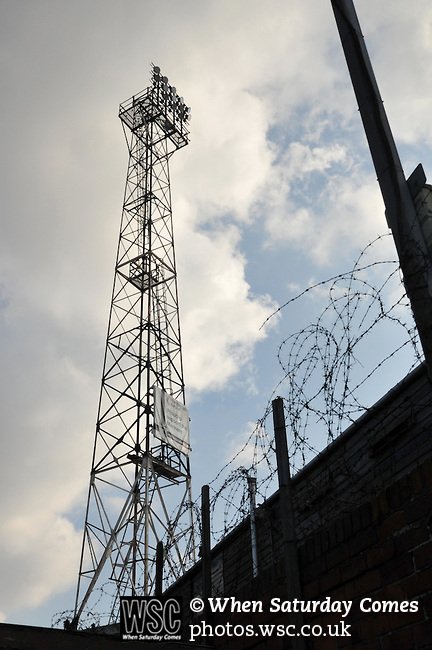
A proper football ground should have prominent floodlights, argued Simon Inglis in WSC 196, June 2003 – otherwise how will away fans find the match?
25 September ~ We’ve all been there. Driving to a game, negotiating the ring-roads and roundabouts of Awaysville, then growing hotter and more bothered as you realise the back streets in which you’re mired are nowhere near the ground. What’s worse is you’ve never had to look at a map before. All you’ve ever done was take more or less the right turn-off from the motorway and then drive blithely toward that distant set of floodlights on the horizon, like a moth homing in on a night light.
But now? Maybe no problem at Old Trafford, Elland Road or St James’ Park (the larger of the two) where the sheer mass of the stadium makes it impossible to miss. But most other places, forget it. If the beacon-like pylons that once rendered map reading unnecessary haven’t been replaced by discreet roof-mounted lights, the chances are they’ve transmuted into slender galvanised masts that are nigh impossible to make out against anything other than the bluest of skies.
A proper football ground, I think we’re all agreed, should have prominent floodlights. Or rather, it should have four prominent floodlight towers that clearly express from afar the rectangular shape of the pitch. Like the spire of a distant church, they should announce: “Local landmark. Place of worship.”
Not that such obvious totems have always been foolproof. Before the JJB Stadium opened in Wigan, Springfield Park (round ball) and Central Park (oval) possessed uncannily similar pylons. That was my excuse for missing the kick-off, anyway. Maybe you too have been similarly lured into a wrong turn by the forests of pylons around Teesside or in parts of the east Midlands coalfields. I walked for miles towards a quartet of floodlights in Sweden once, only to find them standing sentinel over, ahem, a motorway interchange.
This, of course, is a relatively modern dilemma. After the first experiments with floodlighting, starting famously at Bramall Lane in 1878, permanent floodlighting finally arrived in British football in the early 1950s. Even so this was 20 years after it had been introduced at various north and south American stadiums. (Baseball’s first regular night games took place in 1930, spreading to the major leagues by 1935.) The Netherlands were pioneers also, thanks to the Philips Electrical Company of Eindhoven, who installed Europe’s first floodlight towers at Amsterdam’s Olympic Stadium in 1934. Mighty fine and futuristic they were too.

Our own far-sighted FA, meanwhile, threatened to ban any club that played a floodlit game, despite the existence, after 1926, of floodlit greyhound tracks and two demonstrations at White City (of rugby league and football) in 1932-33. It’ll never catch on, claimed a string of experts, the venerable Charles Buchan among them.
But there was no turning back (or off) after the Second World War. From 1949 telegraph poles started popping up along touchlines all over Britain to bear the new generation of improvised floodlights. Non-league South Liverpool were probably the first, at their Holly Park ground, in September 1949 (having been inspired during a visit to the Netherlands the year before). A year later, Headington (now Oxford) United borrowed lamps from college buildings usually illuminated at night. Bristol City’s, on removable poles, had to be switched on one by one. Even Spurs started off, in 1953, with the most basic of poles in each corner. As with Anfield’s lights, installed also on poles in 1957, they barely rose above the roof lines of the stands.
Also among the early birds in 1951, both Arsenal (who’d used basic lighting for training since 1936) and Southampton mounted floodlights on their stand roofs, as is the modern way. But the Saints and Gunners were the exception, each having stands of a similar height on either side of the pitch. Elsewhere, as poles soon proved inadequate – being too low and therefore dazzling players and spectators alike – pylons took over.
It was also an era of austerity. Although floodit friendlies against exotic opposition were the decade’s top draw – as seen most famously at Molineux with the visits of Honved, Moscow Dynamo and Spartak – a full set of pylons and lights was by no means cheap. Stockport County, then in the Third Division North, shelled out £17,000 for theirs in 1956, at a time when England’s record transfer fee was just £34,500. A few months later Manchester United paid £40,000.
Overall, two main designs dominated. The most common, supplied by GEC, was the tapering pylon with a rectangular gantry secured by angled tie rods at the top, holding a grid of, say, 6 x 8 or 6 x 9 lamps. Heights varied according to location from roughly 90 to 180 feet, but the lower half of struts always followed the same criss-cross pattern.

Several survive, at Shrewsbury, Orient, Fulham, Darlington, Cambridge United and Cardiff City, inter alia. Ones that have gone? Palace, Wrexham, Oxford United, Spurs, both Nottingham clubs, Stirling Albion, West Brom and Aston Villa (where, as an amusement to drivers crossing Spaghetti Junction during the 1970s, the lamps were arranged as an A and a V).
But my favourite, if one dares admit to it, was the style most frequently seen in Scotland, at, for example, Hampden, Celtic, Hearts and Hibs, but also, oddly, at Brighton. Called “Drenchliting” and supplied by Millers of Edinburgh, it had a fairly normal tapering pylon, but with a gantry at the top that consisted of open ended horizontal bars, angled down as if bowing in homage to the pitch. Newcastle, I believe, had the tallest such set, some 190 feet tall. Only a few survive, at Queen of the South and Dundee United, to my knowledge.
And what of today’s floodlights? The majority of large stadiums now sport roof-mounted lights, which are easier to maintain and direct, while in smaller grounds, simple (ie bland) masts or columns are taking over. Some, as at Scunthorpe, Chester and Ross County, are on huge hinges, allowing the lights to be lowered and maintained. Some, as at Blackburn, Charlton and QPR, have a wider girth and a more continental air.
Thankfully there are still some designers who make a feature of floodlights. Go to Bolton’s Reebok Stadium, where the leaning, three-legged corner pylons form part of the roof structure and appear like inquisitive robot insects peering over the edge. Or to Hearts, Huddersfield, Preston, Watford or West Bromwich, where one-off designs add a real touch of class, or at least variety, to the overall look.
But if you’re still feeling nostalgic, visit the excellent National Football Museum at Preston, where you can see old floodlights bulbs collected by Preston North End fan Mike Pye. My favourite is the one he rescued from Bradford Park Avenue; a two kilowatt monster version of an ordinary household bulb which looks like a prop from Honey I Shrunk the Kids. Mike sounds embarrassed when I ask him to explain his predilection. “I realise it’s unusual,” he replies, “but I suppose they’re evocative of a golden era. When I was a kid I walked three miles to Deepdale, and it was just part of the build-up to the game, heading towards those pylons.” Fear not Mike. We’ve all been there. Simon Inglis
This article first appeared in WSC 196, June 2003. Subscribers get free access to the complete WSC digital archive – you can find out more details here
Top photo by Colin McPherson/WSC Photos: Floodlights at Greenock Morton’s Cappielow Park
Second photo by Simon Gill/WSC Photos: The Oakwell floodlights stand out above Barnsley
Third photo by Simon Gill/WSC Photos: Blundell Park, home to Grimsby